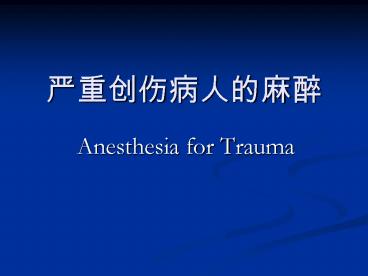Anesthesia for Trauma - PowerPoint PPT Presentation
1 / 33
Title: Anesthesia for Trauma
1
?????????
- Anesthesia for Trauma
2
- In advanced countries, injury ranks as the fourth
leading cause of death following heart disease,
cancer, and cerebrovascular disease.
3
Preoperative Assessment
For trauma patients, in addition to the ordinary preanesthetic evaluation, the severity of the trauma should be evaluated. The commonly used scoring system including 1. ASA physical status score It is not very useful for discriminating small difference in severely injured patients.
4
2. Glasgow coma score scale(GCS) Indicators Eye opening Spontaneous 4 To voice 3 To pain 2 None 1 Verbal response Oriented 5 Confused 4 Inappropriate words 4 Incomprehensible words 2 None 1
5
Motor responses Obeys Command 6 Localizes pain 5 Withdraws(pain) 4 Flexion(pain) 3 Extension(pain) 2 None 1 Numeric range315 Lower score more serious coma
6
3. Revised Trauma Score(RTS) IndicatorsSystolic blood pressure 89mmHg 4 7689mmHg 3 5075mmHg 2 149mmHg 1 No pulse 0 Weight 0.7326 Respiratory rate 1029/min 4 gt29/min 3 69/min 2 15/min 1 None 0 Weight 0.2908
7
Glasgow Coma Scale 1315 4 912 3 68 2 45 1 3 0 Weight 0.9368 Numeric range 00.784 SBPwgtRRwgtGCSwgtTS Lower Score more serious injury 4. Others Refer to the text.
8
Mechanisms of Injury The mechanism of injury determines the pattern of injury, and the knowledge focuses the treatment priorities for the patient. For example Penetrating thoracic trauma Blunt Chest trauma The therapeutic approach is quite different.
9
Blunt trauma results in widespread energy transfer to the body. When the limits of lord tolerance are exceeded, Tissues are disrupted depending on the amount of energy transfer.
10
- Penetrating trauma injures as the energy
behind - the penetrating instrument causes stretching
and - crushing of tissues. The energy dissipation
profiles of different weapons(Knives and bullets
determine the anatomic depth and extent of
maximum injury.
11
Trauma patients death demonstrate a trimodal distribution. In the first and largest peak of distribution curve, death from either blunt or penetrating trauma occurs immediately following widespread laceration of the brain or major blood vessels, including the heart. Such patients can rarely be saved.
12
- In the second peak, exsanguinations from
vascular injuries causes death within a few
hours without medical treatment. - Inadequate or delayed shock resuscitation
or surgical treatment leads to late death from
infection, sepsis, or multiorgan failure.
13
????? ????????,??????????? ????? ????? ????? ?????? ??????????,????? ???????????? Parr?Grande????????????????
14
I. Overview A. Perform visual scan of patient for obvious injures. B. Obtain history from prehospital personnel and patient(if able) ?. Primary survey(ascertainABCDEs) A. Airway maintenance(with cervical spine control) 1. Look for chest wall movements, retraction and nasal flaring 2. Listen for breath sound, stridor, and obstructed ventilation. 3. Feel for air movement
15
- B. Breathing(give supplemental oxygen)
- 1. Determine whether ventilation is adequate
- 2. Inspect chest to exclude open pneumothorax,
- sucking chest wound, or flail segment
- 3. Ausculate for bilateral breath sounds
- 4. Provide assisted ventilation for
ventilatory - failure
16
C. Circulation(establish venous access) 1. Check peripheral pulses, capillary refill, and blood pressure 2. Obtain electrocardiogram 3. Grade shock according to vital signs 4. Correct hypovolemia and obtain blood samples
17
- D. Disability(determine neurologic
status) - 1. Evaluate central function
- Aalert Vresponds to vocal stimulus
- Presponds to painful stimulus
- UUnresponsive
- 2. Evaluate pupil response to light
- EExpose patient for complete examination
- ?. Resuscitation phase
- ?. Secondary surrey
- ?. Definitive care phase
18
???????????????????? ????? ???? 1.?????????????????? ???????????????????? ???????????(?????)???? ?????????????????????? ????????
19
2.??????,???? (1)?????????????????? ???? ???????????? ??????????,????????? ?????????????
20
- (2)?????????????
- (3)??(LMA)????????
- ???
- (4)??????
- (5)?????
21
3.????? ????????????????? ? ????????????,??? ????????????
22
- ? ????????????????,??
- ???????????,????????
- ??????????????????,?
- ??????,????????????
- ? 75???????????????
- 4.???????????????????
- 5.?? ?????,?????????
23
Changes in vital signs with percent blood volume lost in hemorrhage Changes in vital signs with percent blood volume lost in hemorrhage Changes in vital signs with percent blood volume lost in hemorrhage Changes in vital signs with percent blood volume lost in hemorrhage Changes in vital signs with percent blood volume lost in hemorrhage
Vital signs 15 1530 3040 40
Heart rate lt100 gt120 gt120 gt140
Systolic blood pressure Normal Normal Decreased Decreased
Pulse pressupe Normal to increased Decreased Decreased Decreased
Capillary refill Normal Delayed Delayed to Absent Absent
Respiratory rate 1420 2030 3040 gt35
CNS-mental status Anxious More anxious Anxious and Confused Confused to lethargic
24
- ??????
- ?????????????????
- 1.????????????????,?
- ??????????????????????
- ?????????????
- 2.??????????????????
- ???????
- 3.???????????
- 4.??????????,????????
- 5.???????????
25
???????????? 1.???? ???????? ?????? ?????????????????? ???,???
26
- 2.????
- (1)???????????????????
- ???????????????
- ????
- ? ???
- ? ????
- ? ????
- ? ????????????????????
- ???????,?????????
27
(2)?????????????????? ??????????????????? (3)?????????????????? ?????????????? ??????? ???????????????
28
Montoring choices for Trauma Patients Montoring choices for Trauma Patients
Noninvasive
Essential ECG for heart rate and rhythm,noninvasive blood pressure, respiratory rate, Temperature, SaO2, ETCO2 with waveform
Optional Concentrations of anesthetic and respiratory gases (e.g. Mass spectrometry, Transcutaneous)
29
Invasive Foley catheter urine output, intra-arterial pressure catheter, central venous pressure catheter Transesophageal echocardiography
Indications for Massive hemorrhage
Pulmonary Pretraumatic heart disease
artery Multiple systems injuries/Mechanism of injury
catheter Monitoring of cardiac output and oxygen consumption
Optimization of fluid therapy in head-injured patient
30
???????? 1.????????????????,? ???????,?????????? ?????????? 2.?????,???????????? ?,???????????????? ????,?????(Titration)?? ??
31
- 3. ?????????,?????????? ????????????????????????
(???????),?????????? - 4. ???????????,?????????????(??),???????
- ??????
- ????
- ?????
- ???????
32
5.????????? (1)??????????????? ??? (2)?????????????? ???????????????? ??????
33
- (3)????????????????????
- ????????????????????
- ?????????????,???????
- ?????
- ????????????????????
- (4)????????????????????
- ??????????

